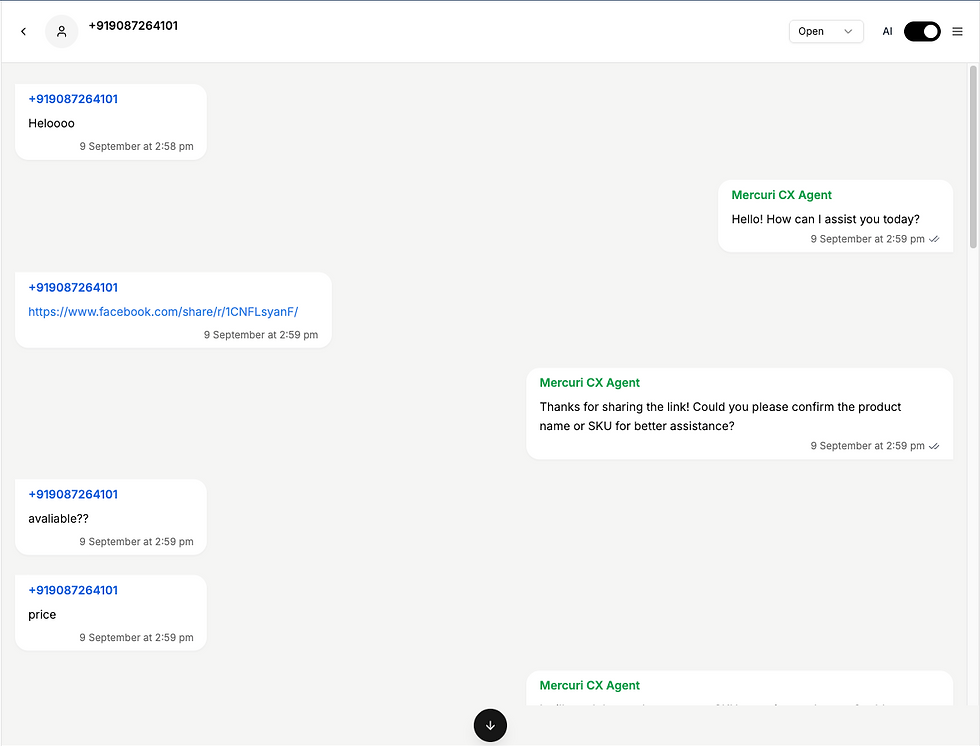When Screenshots Become Shopping Requests: A New Challenge for eCommerce Stores
- Karthik Manjunath

- Sep 12
- 3 min read

If you run an eCommerce business today, chances are you’ve experienced this: A customer messages your WhatsApp or Instagram inbox with a screenshot of a product post—no link, no product name—just the image. They’ll ask:
“Do you have this in stock?”
“What’s the price for this?”
“Is this available in another size or color?”
This behavior of screenshot shopping has become increasingly common as Instagram has evolved into a major platform for product discovery. Shoppers are acting on impulse—they see something they like, take a screenshot, and message the business directly on WhatsApp.
Instagram isn’t just for entertainment anymore; it’s become a shopping engine. In fact, 61% of social users say Instagram inspires their next purchase, and half of its users interact with brands daily.
Nearly 7 in 10 agree Instagram has the most engaging brand content, with many even wishing brands used it more. Most importantly, 29% of users actually buy on the platform, making Instagram not just a discovery channel, but a full funnel for commerce.
Why This Is a Problem for Store Owners
Lost Context – A screenshot doesn’t include product details, SKU, or even the original post’s caption. Your team has to guess which product it is.
Manual Workload – Staff must search through your catalog or feed to identify the item, which is time-consuming and prone to mistakes.
Slower Responses – Every extra step adds delay. And in e-commerce, delays can mean missed sales.
Fragmented Customer Journey – The path from discovery to purchase is no longer a linear process. Without a streamlined process, you risk losing the customer before checkout.
What This Trend Tells Us
Customers are signaling a strong intent to buy, but they’re doing it outside the traditional eCommerce flow. They expect instant, personalized replies on messaging apps—not to be redirected to your website or catalog.
How Businesses Can Respond
Organize Your Catalog for Quick Reference: Keep your product catalog accessible to your support team so they can identify products faster.
Standardize Internal Tags or SKUs: Make it easy for your staff to search by image or keyword.
Use Messaging Tools That Support Context: Platforms like Mercuri (or similar inbox tools) can integrate your product catalog, helping your team respond with accurate pricing and availability instantly.
Train Your Team for Social Commerce: Prepare scripts or guidelines for handling screenshot-based queries so customers get a fast, clear response.
The Bigger Picture
This shift highlights how social media and messaging are reshaping commerce. Customers don’t see channels—they just see your brand. Meeting them where they are isn’t a “nice-to-have” anymore—it’s essential for staying competitive.
Step-by-Step: Handling Screenshot Shopping Queries Efficiently

Centralize Your Conversations: Use a shared inbox to manage WhatsApp and SMS messages in one place. This prevents queries from slipping through cracks.
Organize Your Catalog: Tag your products consistently—by image, SKU, or keyword—so staff can quickly search and match screenshots.
Set Up Fast-Reply Templates: Pre-write responses for common requests (“This item is available in sizes S–L. Would you like me to add it to your cart?”) to speed up replies.
Leverage AI for Product Recognition: At Mercuri, we’ve trained our AI Agents on your entire product image set. When a customer sends a screenshot, the AI can:
Instantly identify the product from the image.
Answer questions about availability, price, colors, or sizing—automatically.
Offer a purchase link or next steps without human intervention.
This means even when your team is busy or offline, customers get quick, accurate answers—keeping the momentum toward purchase.
Analyze and Optimize: Track how many sales start with screenshots to understand what’s resonating on Instagram and refine your social strategy.



Comments